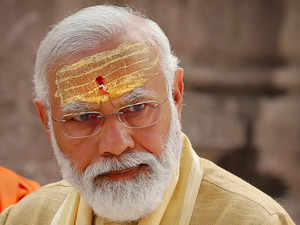Synopsis
Was the BJP’s ‘400 paar’ an over-confident pitch that flew far above the ground reality? Modi has certainly driven the economy ahead at a scorching pace, but the opposition was able to foreground the persisting challenges.
 AP
APThe BJP’s roaring slogan of ‘Abki baar 400 paar‘ started dying down as the results for the Lok Sabha elections began trickling in today. Early trends show the NDA struggling to cross the 300-seat mark. It is likely that the BJP will scrape through but with a shrivelled majority. The BJP’s aim of 370 seats for itself and 400 for the NDA bloc of parties it leads lies shattered well before all the results are in.
The triumphalist slogan of ‘400 paar’ had been echoing throughout India and even a few exit polls had predicted the NDA to cross the 400 mark. Many leaders of the opposition’s INDIA bloc had shown despondence at the exit poll predictions and had positioned themselves to smear the electoral process by doubting the EVMs. However, the early trend today made clear that Prime Minister Narendra Modi will possibly return to power the third time but without the pomp and show of ‘400 paar’.
What could have gone wrong for the BJP which has a gargantuan election machinery and canny leaders at the top who keep their ear to the ground and eyes peeled?
India Shining redux?
Many opposition leaders and analysts had termed the BJP’s ‘400 paar’ campaign as a repeat of the ‘India Shining’ phenomenon. In 2004, the Atal Bihari Vajpayee government had failed to return to power after it ran a confident ‘India Shining’ campaign based on improved economic and social conditions during the Vajpayee government. Many thought ‘India Shining’ airbrushed the ground reality which was not favourable for the BJP. Some thought over-confidence led the party to complacency.
Was the BJP’s ‘400 paar’ an over-confident pitch that flew far above the ground reality? Opposition leaders have been painting a grim picture of the economy even as the economy did exceedingly well during Modi 2.0 despite the Covid disruption. They pointed at the lack of jobs and inequality as the dirty underbelly of the overall shining economy. While there is no doubt the Vajpayee government is known for its path-breaking reforms and kicking off infrastructure growth, the themes Modi later built on, it failed to take into account the vast welter of problems that still dragged India down.
Modi has certainly driven the economy ahead at a scorching pace, but the opposition was able to foreground the persisting challenges. India’s low-inflation and high-growth scenario is indeed a shining exception among the global gloom. But persisting depression in demand in the hinterland, where most Indian voters live, could have cast a shadow.
A united opposition
Most big and small opposition parties sinking their differences and coming together to form the INDIA bloc could have made a huge difference. The INDIA bloc took away the BJP’s substantial advantage of minority votes getting divided among the opposition parties. Possibly dreading this prospect, the BJP had been trying to make inroads into Muslim and Christian voter bases for a few years.
The fragmented opposition vote getting consolidated on a large number of seats must have become the BJP’s biggest hurdle for its run to the 400-paar target.
The tempting offers
Rahul Gandhi had made offers to people, those at the bottom of the pyramid, and various caste groups, which they might have found difficult to refuse. Rs 1 lakh to every poor woman was a mega freebie offered by Rahul. Even if one-third of all women were to be targeted, the offer would have cost more than half of India’s whole annual budget. Since the poll math is not required to agree with the actual math, the offer, highlighted in dream-come-true campaign ads, must have pulled a lot of poor voters from the BJP’s fold.
The INDIA bloc had a few other tempting offers such as the removal of the 60% cap on job quotas and abolishing the Agniveer scheme of military recruitment. To top it all, Rahul Gandhi rolled out his radical agenda of redistribution of wealth, cheered on by a few prominent global economists. It could be reasonable to believe that Rahul was able to sell this dream of revolution to a sizable chunk of voters.
BJP’s lack of a big-bang issue
Ram Mandir was the only mega electoral plank of the BJP but since it came months before elections, its electoral utility had possibly worn off. Modi’s promise to fast-track the economy and make it the world’s third-largest failed to enthuse a part of its support base like the surgical strikes did in 2019. The shining infrastructure that Modi has built at a mega scale and rapid pace had long been factored in by his voters.
Modi’s decade-long rule has raised expectations among his supporters and probably they waited for some big-bang election issue that did not come.

